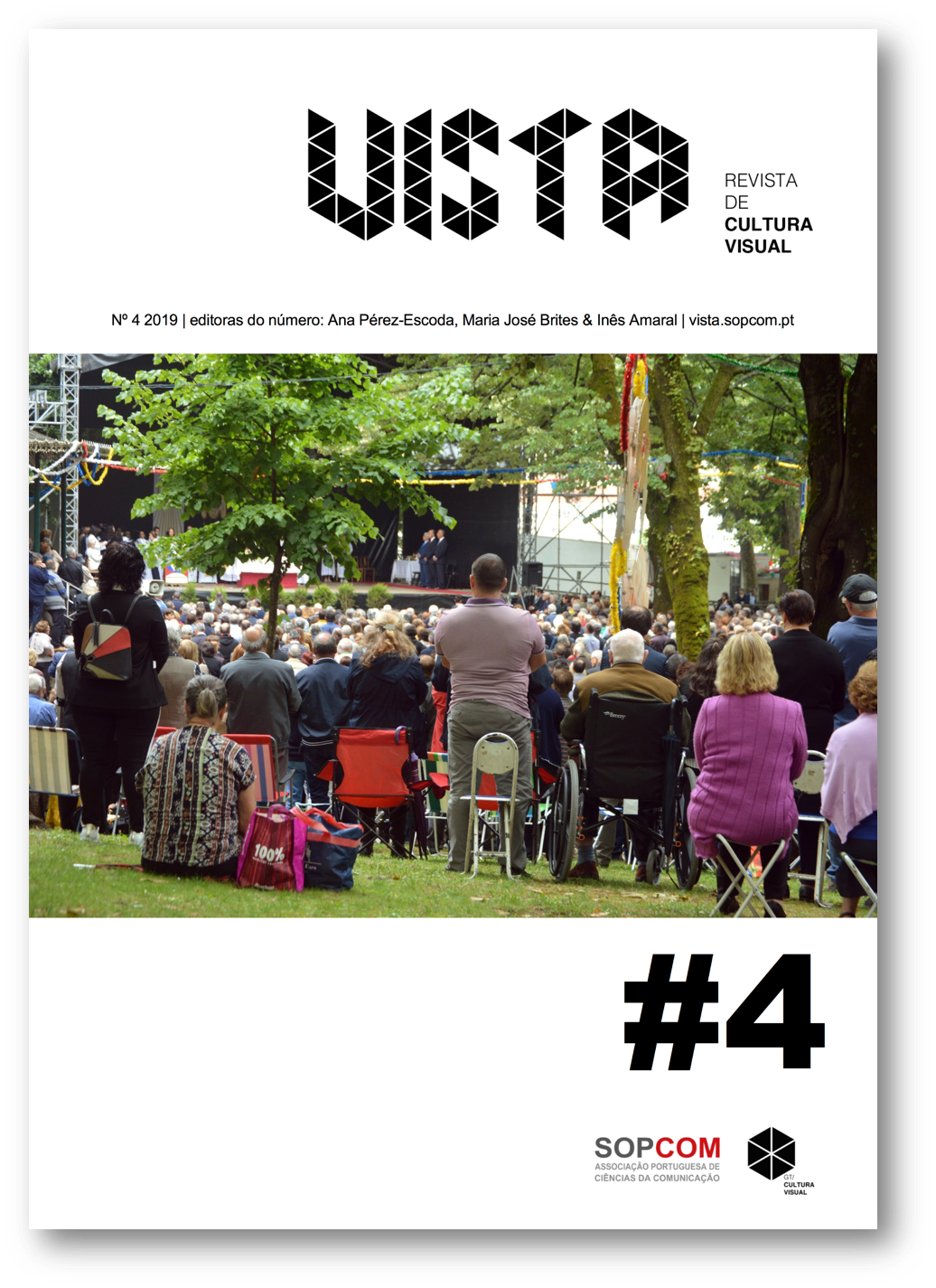Portrayal of Life Stages on Swedish Municipal Media: A Life Course Perspective
DOI:
https://doi.org/10.21814/vista.3017Palavras-chave:
curso da vida, fases da vida, retrato midiático, idosos, análise visualResumo
O retrato midiático de idosos é concebido como uma forma de expressão de realidades e expectativas sociais, e a imagem do envelhecimento tem implicações significativas nas relações inter geracionais. Uma perspectiva de curso da vida é sugerida para observar a velhice como a etapa final de desenvolvimento sucessivo da vida e para investigar o significado social da velhice através da comparação entre fases da vida. Este artigo focará em retratos visuais de cidadãos em uma fase específica da vida (primeira infância, infância, adolescência, maioridade e velhice) na nova mídia municipal sueca. Este artigo visa responder à maneira que a municipalidade constrói o retrato visual de cidadãos em diferentes fases da vida, e quais retratos midiáticos de idosos foram produzidos sob uma perspectiva de curso da vida. Para esse estudo, foram executadas análises documentais de diretrizes municipais de linguagem visual e outros documentos pertinentes, também foi realizada uma elaborada análise visual de seis fotos representativas do Facebook publicadas pela municipalidade em 2018. Este artigo revela que a municipalidade formalizou diversidade e inclusão (inclusive etária) como dois objetivos vitais de comunicação, assim como fez uso de uma técnica de agrupamento por fases da vida para análise de audiência. O resultado da análise visual sugere que o retrato visual dddddde cidadãos se comunica com um conjunto de traços atribuídos às fases da vida representadas. Especificamente, o resultado sugere que certos componentes visuais servem para categorizar idosos como um grupo vulnerável, perpetuando estereótipos etários e discriminação geracional na sociedade.
Downloads
Referências
Adami, E., & Jewitt, C. (2016). Special Issue: Social media and the visual. Visual Communication, 13(3), 263–270.
Appel, M., & Weber, S. (2017). Do mass mediated stereotypes harm members of negatively stereotyped groups? A meta-analytical review on media-generated stereotype threat and stereotype lift. Communication Research DOI: 10.1177/0093650217715543.
Armstrong, T. (2007). The Human Odyssey: Navigating the Twelve Stages of Life. New York City: Sterling Publishing Company.
Bai, X. (2014). Images of ageing in society: A literature review. Journal of Population Ageing, 7(3), 231–253.
Bene, M. (2015). The political construction of old age as reflected in online discussions. Corvinus Journal of Sociology and Social Policy, 6(1), 25–45.
Bergman, Y. S., & Bodner, E. (2015). Ageist attitudes block young adults’ ability for compassion toward incapacitated older adults. International Psychogeriatrics, 27(9), 1541–1550.
Bradley, D., & Longino, C. (2001). How older people think about images of aging in advertising and the media. Generations, 25(3), 17–21.
Clair, J. M., Karp, D. A., & Yoels, W. C. (1993). Experiencing the Life Cycle: A Social Psychology of Aging. Springfield: Charles C Thomas.
Cohen, H. L. (2002). Developing media literacy skills to challenge television’s portrayal of older women. Educational Gerontology, 28(7), 599–620.
Degnen, C. (2007). Minding the gap: The construction of old age and oldness amongst peers. Journal of Aging Studies, 21(1), 69–80.
Elzinga, C. H., & Liefbroer, A. C. (2007). De-standardization of family-life trajectories of young adults: A cross-national comparison using sequence analysis. European Journal of Population/Revue européenne de Démographie, 23(3-4), 225–250.
Entwisle, D. R. (2018). Children, Schools, and Inequality. London: Routledge.
Erol, P. Ö. (2009). Social construction of Old Age among university students in Turkey. Sincronía, (1), 1–16.
Fischer, J. L., Zvonkovic, A., Juergens, C., Engler, R., & Frederick, H. (2015). Work, family, and well-being at midlife: A person-centered approach. Journal of Family Issues, 36(1), 56–86.
Foss, K. A., & Southwell, B. G. (2006). Infant feeding and the media: the relationship between Parents’ Magazine content and breastfeeding, 1972–2000.International Breastfeeding Journal, 1(1), 1–10.
Government Offices of Sweden, Ministry of Finance. (2017). The Swedish Model. Retrieved from Government Offices of Sweden website: https://www.government.se/information-material/2017/06/the-swedish-model/
Hansen, A., & Machin, D. (2013). Media and Communication Research Methods. London: Palgrave Macmillan.
Healey, T., & Ross, K. (2002). Growing old invisibly: older viewers talk television. Media, Culture & Society, 24(1), 105–120.
Henderson, L., Kitzinger, J., & Green, J. (2000). Representing infant feeding: content analysis of British media portrayals of bottle feeding and breast feeding. BMJ, 321(7270), 1196–1198.
Holstein, J. A., & Gubrium, J. F. (2007). Constructionist perspectives on the life course. Sociology Compass, 1(1), 335–352.
Jamieson, P., & Romer, D. (2008). The Changing Portrayal of Adolescents in the Media Since 1950. Oxford: Oxford University Press.
Jewitt, C., & Oyama, R. (2001). Visual meaning: A social semiotic approach. In Van Leeuwen, T., & Jewitt, C. (eds.), Handbook of Visual Analysis (pp. 134-156). Sage Publishing.
Kessler, E. M., Rakoczy, K., & Staudinger, U. M. (2004). The portrayal of older people in prime time television series: The match with gerontological evidence. Ageing & Society, 24(4), 531–552.
Kroon, A. C., Van Selm, M., Ter Hoeven, C. L., & Vliegenthart, R. (2018). Reliable and unproductive? Stereotypes of older employees in corporate and news media. Ageing & Society, 38(1), 166–191.
Larsson, A. O. (2013). Bringing it all back home? Social media practices by Swedish municipalities. European Journal of Communication, 28(6), 681–695.
Lee, B., Kim, B. C., & Han, S. (2006). The portrayal of older people in television advertisements: A cross-cultural content analysis of the United States and South Korea. The International Journal of Aging and Human Development, 63(4), 279–297.
Lee, M. M., Carpenter, B., & Meyers, L. S. (2007). Representations of older adults in television advertisements. Journal of Aging Studies, 21(1), 23–30.
Lees-Maffei, G., & Maffei, N.P. (2019). Reading Graphic Design in Cultural Context. London: Bloomsbury Publishing.
Lepianka, D. (2015). How similar, how different? On Dutch media depictions of older and younger people. Ageing & Society, 35(5), 1095–1113.
Lesko, N. (2012). Act Your Age!: A Cultural Construction of Adolescence. London: Routledge.
Loos, E. (2013). Designing for dynamic diversity: Representing various senior citizens in digital information sources. Observatorio (OBS*), 7(1). 21–45.
Loos, E., & Ekström, M. (2014). Visually representing the generation of older consumers as a diverse audience: T owards a multidimensional market segmentation typology. Participations, 11(2), 258–273.
Loos, E., & Ivan, L. (2018). Visual ageism in the media. In Ayalon, L., & Tesch-Römer, C. (eds). Contemporary perspectives on ageism (pp. 163–176). Berlin: Springer.
Loos, E. F., Ivan, L., Fernández-Ardèvol, M., Sourbati, M., Ekström, M., Wili ska, M., Carlo, S., & Schiau, I. (2017). Ageing well?: A cross-country analysis of the way older people are visually represented on websites of organizations for older people. Journal of Comparative Research in Anthropology and Sociology, 8(2), 63–83.
Lumme-Sandt, K. (2011). Images of ageing in a 50+ magazine. Journal of Aging Studies, 25(1), 45–51.
Matthews, S. H. (1979). The Social World of Old Women: Management of Self- identity (78). Sage Publishing.
McMunn, A., Lacey, R., Worts, D., McDonough, P., Stafford, M., Booker, C., ... & Sacker, A. (2015). De-standardization and gender convergence in work–family life courses in Great Britain: A multi-channel sequence analysis.Advances in Life Course Research, 26, 60–75.
Mergel, I. (2013). A framework for interpreting social media interactions in the public sector. Government Information Quarterly, 30(4), 327–334.
Milner, C., Van Norman, K., & Milner, J. (2012). The media’s portrayal of ageing. Global Population Ageing: Peril or Promise?, 25–28.
Moschis, G. P. (1996). Gerontographics: Life-stage segmentation for marketing strategy development. Santa Barbara: Greenwood Publishing Group.
Moschis, G. P. (2012). Consumer behavior in later life: Current knowledge, issues, and new directions for research. Psychology & Marketing, 29(2), 57–75.
Narvanen, A. L. (2018). Age, ageing and the life course. In Öberg, B.-M., Närvänen, A.- L., Näsman, E. & Olsson, E. (eds), Changing Worlds and the Ageing Subject: Dimensions in the Study of Ageing and Later Life (pp. 87–102). London: Routledge.
Nelson, E. A., & Dannefer, D. (1992). Aged heterogeneity: Fact or fiction? The fate of diversity in gerontological research. The Gerontologist, 32(1), 17–23.
OECD. (2018). Digital Government Review of Sweden. Retrieved from OECD website: https://www.oecd.org/gov/digital-government/digital-government-review-of-sweden- 2018.pdf
Olesen, T. (2018). More than words? A test of the effect of emotionally charged photographs. Nordicom Review, 39(2). 35–48.
Prieler, M., Kohlbacher, F., Hagiwara, S., & Arima, A. (2015). The representation of older people in television advertisements and social change: the case of Japan. Ageing & Society, 35(4), 865–887.
Robinson, T., & Callister, M. (2008). Body image of older adults in magazine advertisements: A content analysis of their body shape and portrayal. Journal of Magazine and New Media Research, 10(1), 1–16.
Robinson, T., & Popovich, M. (2003). Older adults’ perceptions of offensive senior stereotypes in magazine advertisements: Result of a Q method analysis. Educational Gerontology, 29(6), 503–519.
Sedick, S., & Roos, V. (2011). Older people's portrayal in the print media: implications for intergenerational relations. Journal of Psychology in Africa, 21(4), 549–554.
Skelton, T. (2002). Research on youth transitions: some critical interventions. In: Cieslik, M. & Pollock, G. (eds). Young People in Risk Society: The Restructuring of Youth Identities and Transitions in Later Modernity (pp. 100–116). Aldershot: Ashgate.
Tiidenberg, K. (2018). Visibly ageing femininities: women’s visual discourses of being over-40 and over-50 on Instagram. Feminist Media Studies, 18(1), 61–76.
Trentham, B., Sokoloff, S., Tsang, A., & Neysmith, S. (2015). Social media and senior citizen advocacy: an inclusive tool to resist ageism? Politics, Groups, and Identities, 3(3), 558–571.
Vesperi, M. (1985). City of Green Benches: Growing Old in a New Downtown. Ithaca: Cornell University Press.
Vidovićová, L., & Honelová, M. (2018). A case study of ageism in political debates: are social media a latent source of generational hatred? Slovensky Narodopis, 66(2), 203– 220.
Volk, A. A., Lukjanczuk, J. L., & Quinsey, V. L. (2007). Perceptions of child facial cues as a function of child age. Evolutionary Psychology, 5(4), 801–814.
Ylänne, V. (2015). Representations of ageing in the media. In Twigg, J. & Martin, W. (eds). Routledge Handbook of Cultural Gerontology (pp. 369–376). London: Routledge.
Ylänne, V., Williams, A., & Wadleigh, P. M. (2010). Ageing well? Older people’s health and well-being as portrayed in UK magazine advertisements. International Journal of Ageing and Later Life, 4(2), 33–62.
Zhang, Y. B., Harwood, J., Williams, A., Ylänne-McEwen, V., Wadleigh, P. M., & Thimm, C. (2006). The portrayal of older adults in advertising: A cross-national review. Journal of Language and Social Psychology, 25(3), 264–282.
Zuckerman, B. S., Frank, D. A., & Augustyn, M. (1999). Infancy and toddler years. In Levin, M., Carey, W. & Crocker, A.C. (eds). Developmental-Behavioral Pediatrics (pp. 27–39). Philadelphia: WB Sauders.
Downloads
Publicado
Como Citar
Edição
Secção
Licença

Este trabalho encontra-se publicado com a Licença Internacional Creative Commons Atribuição 4.0.
Os autores são titulares dos direitos de autor, concedendo à revista o direito de primeira publicação. O trabalho é licenciado com uma Licença Creative Commons - Atribuição 4.0 Internacional.












